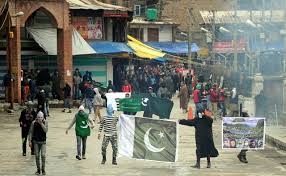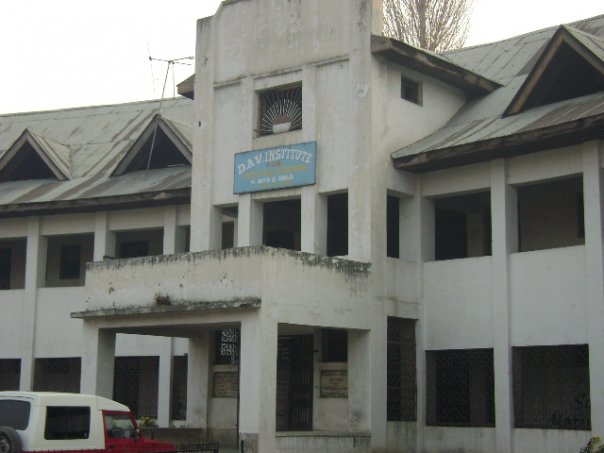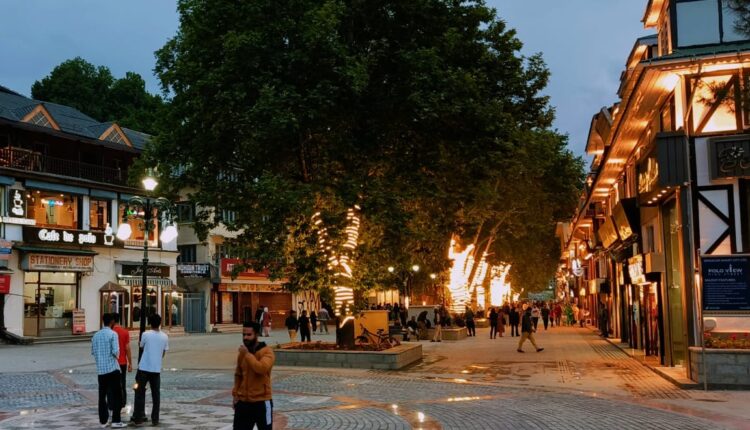Nowhatta, often known as Kashmir’s Gaza strip or Tiananmen Square for being the epicenter of protests and stone-pelting clashes, Monday witnessed an uprising of another sort.
The children and youth from different localities of Srinagar downtown holding qalam, a type of pen made from a dried reed, in their hand and love for Islamic art had come to attend ‘Khush Khat’, a workshop-cum-exhibition of Islamic calligraphy at Islamic Cultural Centre of Jamia Masjid, Srinagar.
The centre, which recently came up at the place made famous by news photographers and television channels by capturing photos and videos of downtown youth holding mostly the Pakistani flags and rarely some Islamic State flags today witnessed religious passions of a different kind.
Aysha Aslam, a 12th standard student from Saida Kadal area of downtown, in her first attempt at Islamic calligraphy became the cynosure of all eyes as calligraphy instructors of Jammu Kashmir Academy of Art, Culture and Languages (JKAACL) were surprised to see her first brush at the art form.
Calligraphy Head at JKAACL, Anwar Lolabi and senior calligrapher, Abdul Salam Kousari both were impressed with the work of around 50 students who attended the workshop on the first day.
Artists, mostly from the old city, had also come up with canvasses in Arabic, Persian, Urdu and Kashmiri languages using both the traditional and modern forms of calligraphy, an art form which has been dying after the advent of computers and their use in printing and publishing technology.
The art lovers were also in for a surprise with the modern calligraphy of contemporary artists like Fida Hussain Rather, Iftikar Jaffar, Nadia Mushtaq Mir, Ishfaq Ali and Taha Mughal.
Nadiya, a postgraduate in economics, is just a year into calligraphy and has already sold more than 20 pieces of her work.
“I had never tried calligraphy until last year when Kashmir was witnessing an extended spell of shutdown following the killing of Burhan Wani,” she said. “Having nothing to do at home, I started calligraphy with acrylic colours on my kitchen tiles.”
After the last year’s internet blockade, she put her work on Instagram and a Kashmiri designer, Shahid Rashid found it interesting and offered her work.
A resident of Kralpora, Nadiya said stereotyping downtown youth as stone pelters was not fair as the best art in Kashmir comes from downtown.
Unlike Nadiya, Ishfaq Ali from Alamgari Bazaar locality of downtown wanted to be a calligrapher since childhood.
However, he rues over the lack of opportunities for the artists from downtown.
“Until today, we did not have any space for an art gallery,” said Ali, who had around 20 of his artworks on display.
A civil society member, Shakeel Qalander was mesmerised to see one of the artworks of these contemporary calligraphers.
“This calligrapher has captured a Naat ‘Marhaba Syed-e-Makki, Madani-ul-Arabi, Dilajaan Baad, Fidayat Chi Ajab Khush Laqabi…,” Qalander said about the Naat written by Kashmiri poet, Allama Jan Muhammad Qudsi, which became a source of over 500 more Naats.
“The Naat of Qudsi, who is buried at Mazari Shoora at Drugjan, Dalgate, had become so famous that during the annual Rabi-ul-Awal Tarhi Mushari, every poet was asked to write a Naat with the initial lines originating from this Qudsi’s Naat,” Qalander said. “Even the famous Qawals, Sabri Brothers used verses from Qudsi’s Naat in their Qawalis.”
The central theme of the workshop-cum-exhibition organised by the Department of Tourism, Kashmir in collaboration with INTACH Kashmir, J&K Academy of Art, Culture and Languages and SkillPro was reviving the art of endangered calligraphy in the region, known for producing master calligraphers like Syed Qasim, Mulla Ahmad Kashmiri, Mulla Hafiz Bagdhadi and their likes.
The event was inaugurated by the oldest-surviving calligrapher from Srinagar, Muhammad Amin Kundangar, 93, known for his gold calligraphy.
Taha Mughal, the Exhibition Coordinator of INTACH, Kashmir said Srinagar downtown, also known as Shehar-e-Khas, was renowned for producing Kashmiri arts and crafts but since 1990 these arts and crafts were dying.
“We are trying to revive these endangered arts and crafts,” he said.
And the revival is happening around Jamia Masjid Srinagar, the hub of Kashmir politics.
Noted architect and Project Coordinator INTACH, Kashmir, Hakim Sameer Hamdani said Jamia Masjid had been a cultural hub and witnessed political movements over a period of time but people living in the area had been migrating to other places over a period of time.
“We are trying to revive the pride that was associated with this area and involve the local community,” he said.
The Tourism department has also been trying to do its bit for the revival.
Director Tourism, Kashmir, Mahmood Ahmad Shah said the department had spent Rs 3.93 crore of the sanctioned Rs 4.29 crore on the development of Jamia Masjid market including improving lightening and beautifying its surroundings to promote downtown for heritage and culture tourism.
“The department is working on developing of Jamia Masjid Heritage Corridor,” he said.
Keeping the Kashmiri heritage alive is what Convenor INTACH Kashmir and a member of National Monument Authority, Saleem Beg has been working for years now.
Beg said knowledge had been democratised in Kashmir with the publication of books with Muslims using calligraphy.
“Kagazgari Mohalla become famous for paper production, Jildgar Mohalla for binding books and thus the printing helped in transforming the lives of people,” he said. “There is a lot of scope for calligraphy today too and the advent of computers cannot kill this art form but only the form of expression has changed.”
Beg said every third home in Srinagar downtown used to have a calligrapher and called for protecting the exclusivity of this region.
Like Beg, Naqshab Afra Afridi is also working on a cause to help the youth from downtown earn livelihood without getting consumed in the service industry.
Afridi, who works for a Hyderabad-based SkillPro organisation, said the focus should be on self-employment of youth rather than providing them wage-employment.
“Institutions like the Awqaf can play a leading role by helping aspiring young entrepreneurs with interest-free soft loans,” he said. “There is a need to focus on cultivation, manufacturing and production instead of services.”
There are takers for Afridi’s advice too.
Saima Malik, a resident of Saffron Colony, Sempora is in the 3rd year of her diploma in Calligraphy at JKAACL.
“If the calligraphers will be innovative, they can go a long way,” she said.
Fayaz Ahmad, who runs Al Haya, a garment shop at the gate of Jamia Masjid, felt let down by small-scale publicity of the event.
“Children from this area should get engaged in such events,” he said. “There is a need to involve youth in such activities as downtown youth are talented at many things, good not just at stone pelting.”
Outside the Islamic Cultural Centre of Jamia Masjid, Srinagar, Aijaz Ahmad, an ice-cream vendor, had a field day as art lovers kept coming to the exhibition and had a taste of his kulfi too.
“We did not do much of business for the past 15 days,” he said referring to the police crackdown on downtown youth since the lynching of a police officer.
Secretary JKAACL Aziz Hajini, noted artist Masood Hussain, senior journalist Shujaat Bukhari, former bureaucrat Ghulam Nabi Qasba and others also attended the event.
Downtown Uprising: Islam at heart, qalam in hand






